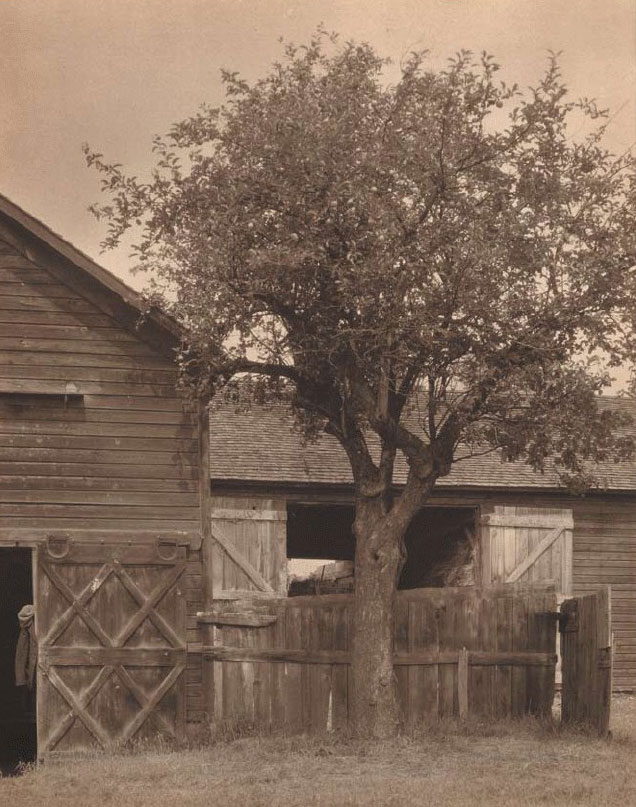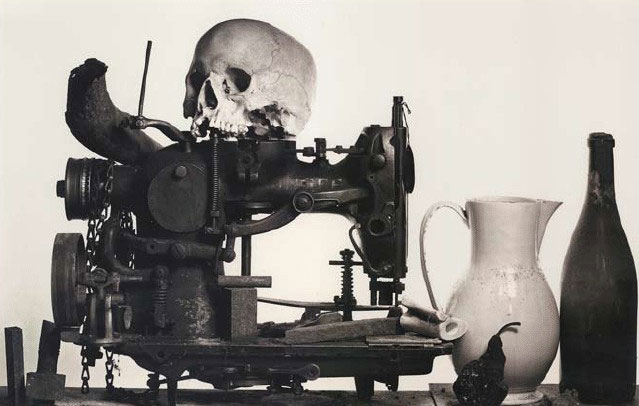- Relief printing
- Intaglio and planographic printing
- Color printing
- Bits and pieces
- Early photography in silver
- Non-silver processes
- Modern photography
- Color notes
- Color photography
- Photography in ink: relief and intaglio printing
- Photography in ink: planographic printing
- Digital processes
- Where do we go from here?
Palladium

Palladium print. Alfred Stieglitz. The Barn. 1922. 9 1/8 x 7 1/8" (23.2 x 18.1 cm) © Georgia O’Keefe Museum / Artists Rights Society (ARS), New York.
The iron compound ferric oxalate turns upon exposure into ferrous oxalate, which can react to a number of salts and reduce them to their metal components. The three metals most often used in old papers involving this iron process were platinum, palladium, and silver. Platinum produced a beautiful neutral-to-slightly-bluish tone, depending on the sizing used on the paper. Palladium was much warmer, and the overall print color was brown, but this metal could also produce a far blacker deposit in the shadows than could platinum. Silver reduced by iron made a greener deposit. A paper called “Satista,” made with this less expensive metal, was used a bit in the first part of the twentieth century, most notably by Paul Strand, but it was quite unstable and never very popular. Both platinum and palladium papers were extraordinarily stable, and prints made with these metals are the most long-lasting of all chemical photographs.

Platinum and palladium print. Irving Penn. Composition with Skull and Pear, New York. 1979. 11 7/8 x 19" (30.2 x 48.3 cm). © 1981 Irving Penn.
The prints must be properly cleared and washed, but no hypo is involved in their production. A properly made platinum might degrade after many years through changes in the paper support; the metal deposit itself is absolutely permanent. The Platinotype company manufactured papers that were pure in either platinum or palladium. They also made some alternate versions that used a mixture of the metals, with names like “Black Palladio.” Homemade platinum prints almost always incorporate both metals. One reason for this is expense: palladium is much cheaper than platinum. The other reason is to get the deep black of palladium coexisting with the neutral tones of platinum. When I printed this way I always kept an eye on the Russian wheat harvest; when it was bad, Russian reserves of palladium and platinum flooded the market, to generate income for the purchase of grain from the United States. The prices of these precious metals fell and I filled my bottles to the brim.
Platinum and palladium prints were touted as having the finest tonal scale, but this is simply not true. The papers had matte surfaces, which cannot hold as long a range of tones as glossy ones. Platinum and palladium have the additional problem of being deposited right in the paper fibers, so that not only are the blacks weak (compared to a gloss black) but the detail in the shadows tends to be obscured by the paper. Nevertheless, a great platinum or palladium print is a wonder, and can convey photographic description in a manner unlike any other process. The secret here is not to judge these prints by comparison to other processes but to view them by themselves. Comparison drags things being judged down to their common denominators, and clouds our eyes to the special qualities of each one.

